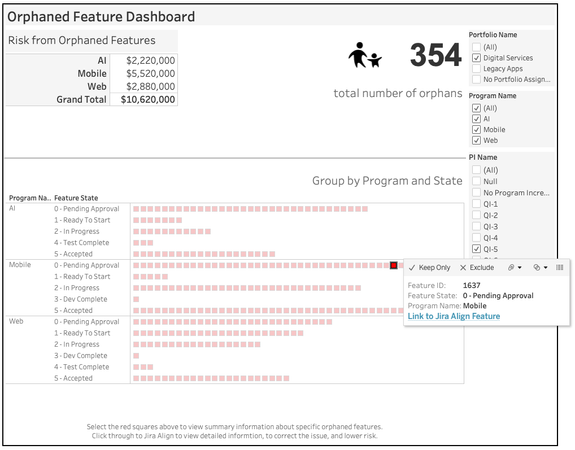Community resources
Community resources
Community resources
- Community
- Products
- Jira Align
- Articles
- Lack of Work Alignment Can Cost Millions
Lack of Work Alignment Can Cost Millions
To have a better understanding of orphaned work and prevent it from costing you Millions of dollars of delivery capacity, visualize the problem/opportunity. You might find orphans before is too late, by creating an executive dashboard with Jira Align and Tableau or Power BI.
This orphaned feature dashboard (pictured above) identifies feature objects that lack parent epic objects. Every orphaned object contains a risk cost. The further an orphaned object progresses along a value stream, the more unrecoverable cost is realized. Other than top-level objects, like investment themes, all (child) objects should have parents. Ensuring all work has a lineage helps ensure full accounting of work in the system of delivery and a complete connection between strategy and execution.
Let’s say that you know the overall delivery capacity of your portfolio and you make a point to balance it with demand. But when you see what your portfolio delivered last quarter, you come up short… way short. When you need to meet the commitments you made to your shareholders, should you hire more people or change the forecasted dates?
Before you decide, in order to better understand overall demand and to balance the system, consider something else. It could be that your delivery teams are working really hard and getting a lot done. They may be working on priorities you didn’t commit to and there is a disconnect between strategy and execution.
These disconnected and misaligned priorities are also known as orphans.
Orphans identify a lack of teamwork alignment, which include child stories without a parent feature on the backlog. Similarly, child features may not have a parent epic on the roadmap. How does this happen? Teams generally get direction from a prioritized backlog that is aligned to a roadmap. Sometimes, teams choose to work on things identified as short-term priorities. Though I do believe in local autonomy, I believe that autonomy should apply to how to create a solution or solve a problem. It should not include changing priorities defined by product owners, managers, or leaders. Every hour spent on orphaned work is one less hour that can be spent on priorities detailed in the backlog and on the roadmap.
Leadership should define outcome-based objectives. Epics should be defined to make measurable progress against those objectives. Those parent epics should be decomposed into child features. Lastly, those features become parents of child stories. By maintaining a lineage, you can ensure alignment to objectives and goals.
Was this helpful?
Thanks!
Derek Huether

About this author
Principal Solutions Engineer
Atlassian
Baltimore'ish
11 accepted answers
Atlassian Community Events
- FAQ
- Community Guidelines
- About
- Privacy policy
- Notice at Collection
- Terms of use
- © 2025 Atlassian







5 comments